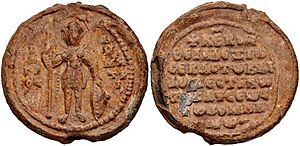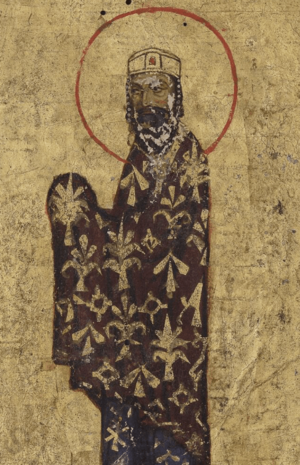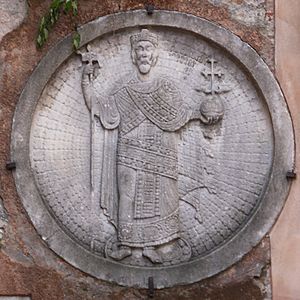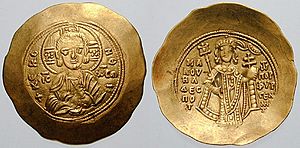Alexios I Komnenos facts for kids
Quick facts for kids Alexios I Komnenos |
|
|---|---|
| Emperor and Autocrat of the Romans | |
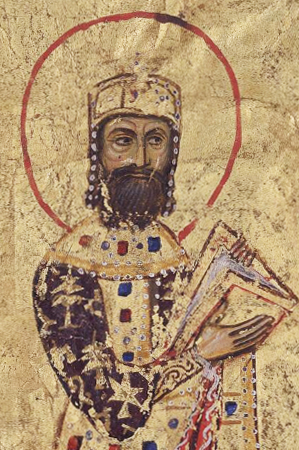
A portrait of Alexios from an old book called Panoplia Dogmatica
|
|
| Byzantine emperor | |
| Reign | 1 April 1081 – 15 August 1118 |
| Coronation | 4 April 1081 |
| Predecessor | Nikephoros III Botaneiates |
| Successor | John II Komnenos |
| Born | c. 1057 |
| Died | 15 August 1118 (aged 61–62) |
| Spouse | Irene Doukaina |
| Issue |
|
| Dynasty | Komnenian |
| Father | John Komnenos |
| Mother | Anna Dalassene |
Alexios I Komnenos (born around 1057 – died August 15, 1118) was a powerful Byzantine emperor from 1081 to 1118. Even though he wasn't the very first emperor from the Komnenian family, it was during his time that this family became very strong. They even started a new tradition where the throne would pass down through their family.
When Alexios became emperor, the Byzantine Empire was in big trouble. It was falling apart and faced constant wars. Enemies like the Seljuk Turks in Asia Minor and the Normans in the western Balkans were attacking. But Alexios was a clever leader. He managed to stop the empire's decline and started a period of recovery. This period is known as the Komnenian restoration, where the empire got stronger in its military, money, and land. Alexios also asked for help from Western Europe against the Turks. This request was a big reason why the First Crusade began.
Contents
Alexios' Early Life and Rise to Power
Alexios was the son of John Komnenos and Anna Dalassene. His uncle, Isaac I Komnenos, was emperor before him. Alexios and his older brother, Manuel, were brave soldiers. They fought well against the Seljuk Turks.
Under later emperors, Alexios continued to serve in the military. He fought against rebels in different parts of the empire. In 1074, he successfully stopped a rebellion by mercenaries in Asia Minor. Later, he became a top commander in the army. He defeated several rebel leaders, showing his skill as a military strategist.
How Alexios Became Emperor
While Alexios was preparing to fight the Normans, a group of powerful families at court, called the Doukas faction, asked him to join a plan against the current emperor, Nikephoros III. Alexios' mother, Anna Dalassene, played a very important part in this plan in 1081.
The empress at the time, Maria of Alania, also joined the plan. She was worried about her son's future. Nikephoros III wanted to give the throne to one of his own relatives, not Maria's son. So, Maria teamed up with the Komnenos family. Maria even adopted Alexios as her son, even though she was only a few years older. This made Alexios and Maria's son, Constantine, adoptive brothers. This was a smart political move to gain support.
In February 1081, Alexios and his brother Isaac left Constantinople to gather an army. Meanwhile, their mother, Anna, took other family members to a famous church, the Hagia Sophia. She pretended to be worried about her sons, but she was actually buying them time. She tricked the emperor into thinking there was no real plot against him.
Anna was very clever. She managed to get her sons time to escape and gather their troops. She also made the emperor feel safe, even though a rebellion was brewing. On April 1, 1081, Alexios and Isaac Komnenos entered the capital city, Constantinople, as winners. They had bribed the guards to let them in.
After becoming emperor, Alexios made sure to keep the support of powerful families. He married Irene Doukaina, who was from the important Doukas family. To keep their support, Alexios first made Constantine Doukas, the young son of Empress Maria, a co-emperor. He even planned for his daughter, Anna Komnene, to marry Constantine.
However, things changed when Alexios' first son, John II Komnenos, was born in 1087. Anna's engagement to Constantine was called off. Constantine lost his title as co-emperor, and Empress Maria retired to a monastery.
Alexios' Many Wars
Alexios' 37 years as emperor were full of challenges. He faced many enemies and had to fight hard to protect the empire.
Fighting the Normans
At the beginning of his rule, Alexios faced a strong attack from the Normans. They were led by Robert Guiscard and his son Bohemund. The Normans captured important cities like Dyrrhachium and Corfu. Alexios lost several battles at first.
But Alexios was smart. He bribed the German king, Henry IV, with a lot of gold. He paid Henry to attack the Normans in Italy. This forced the Normans to go back home to defend their own lands. The Norman threat ended when Robert Guiscard died in 1085. The Byzantines then got back most of the lands they had lost.
Dealing with Rebels and Invaders in the Balkans
Next, Alexios had to deal with problems in the Thrace region. Groups like the Bogomils and Paulicians rebelled. They joined forces with the Pechenegs, who were invaders from beyond the Danube river.
In 1087, the Pechenegs attacked Thrace again. Alexios tried to fight back but was surrounded. He had to sign a peace deal and pay them money. In 1090, the Pechenegs invaded again. At the same time, a Turkish leader named Tzachas tried to attack Constantinople by sea. Alexios solved this problem by making an alliance with 40,000 Cumans. With their help, he completely defeated the Pechenegs in 1091.
This victory ended the Pecheneg threat. But in 1094, the Cumans themselves started raiding Byzantine lands. They were led by someone who claimed to be a long-dead son of a former emperor. Alexios eventually defeated them. With the Balkans mostly peaceful, Alexios could finally focus on Asia Minor, which the Seljuk Turks had almost completely taken over.
The Seljuk Wars and the First Crusade
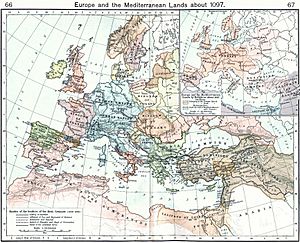
By the time Alexios became emperor, the Seljuk Turks controlled most of Asia Minor. Alexios managed to get back many coastal areas by sending soldiers to raid Turkish camps. But these victories weren't enough to stop the Turks completely.
As early as 1090, Alexios started talking with the Pope in Rome. He wanted help from Western Europe against the Seljuks. In 1095, his messengers met with Pope Urban II. Alexios only wanted some mercenary soldiers, not the huge armies that arrived later.
To his surprise, the Pope preached the First Crusade later that year. This led to the "People's Crusade," a large group of mostly unarmed pilgrims. They caused problems as they traveled through his lands. Alexios quickly sent them to Asia Minor, where the Turks massacred them.
Then came the "Prince's Crusade," a much stronger army of knights and nobles. They arrived in Constantinople. Alexios met with their leaders separately. He made them promise to return any conquered lands to the Byzantine Empire. In return, he promised to supply them with food.
The Crusade was a big success for Byzantium. Alexios got back many important cities and islands. For example, the crusaders helped him take back Nicaea in 1097. After a big crusader victory at Dorylaion, Byzantine forces recovered much of western Asia Minor.
However, the crusaders later felt that Alexios had not helped them enough during the siege of Antioch. One of the crusader leaders, Bohemund, even became the Prince of Antioch. He later fought a short war with Alexios in the Balkans. But Alexios' forces blocked him, and Bohemund agreed to become Alexios' vassal in 1108.
In 1116, even though he was very sick, Alexios led his army to defend his lands in Anatolia from the Seljuk Sultan, Malik Shah. In 1117, he went on the attack and defeated the Sultan at the Battle of Philomelion.
Alexios' Personal Life and Legacy
During the last 20 years of his life, Alexios became less popular. He persecuted followers of certain religious groups, like the Paulicians and Bogomils. One of his last acts was to burn a Bogomil leader at the stake.
For many years, Alexios was strongly influenced by his mother, Anna Dalassene. She was a very smart and capable politician. Alexios even gave her the special title of Augusta, which usually belonged to the empress. Alexios loved military exercises and often led his troops himself. So, his mother Anna managed the empire when he was away fighting. She also took full responsibility for raising and educating his daughter, Anna Komnene.
Who Would Rule Next?
Alexios' final years were also filled with worries about who would become emperor after him. He had crowned his son, John II Komnenos, as co-emperor when John was only five years old in 1092. However, his wife, Irene Doukaina, wanted their daughter Anna and Anna's husband, Nikephoros Bryennios the Younger, to take the throne instead. Bryennios was given important titles, but he remained loyal to both Alexios and John.
Pretenders and Rebels
Besides his foreign enemies, Alexios also faced many rebels who tried to take his throne. Because the empire was going through tough times, Alexios had more rebellions against him than almost any other Byzantine emperor.
Before the First Crusade
- Raictor: A monk who claimed to be a former emperor. Robert Guiscard used him as an excuse to invade the Byzantine Empire.
- A plot in 1084: Several important officials planned against Alexios. He found out and simply banished the richest plotters.
- Tzachas: A Seljuk Turkic leader who called himself emperor in 1092.
- Constantine Humbertopoulos: He had helped Alexios become emperor but then plotted against him in 1091.
- John Komnenos: Alexios' nephew, who was accused of plotting against him.
- Theodore Gabras and his son Gregory Gabras: They were governors who acted almost independently.
- Michael Taronites: Alexios' brother-in-law.
- Nikephoros Diogenes: The son of a former emperor.
- Pseudo-Leo Diogenes: Someone who pretended to be another son of a former emperor.
- Karykes: The leader of a revolt on the island of Crete.
- Rhapsomates: He tried to create his own kingdom on the island of Cyprus.
After the First Crusade
- Salomon: A wealthy senator who plotted against Alexios in 1106.
- Gregory Taronites: Another governor of Trebizond.
- A plot in 1107: A descendant of a Bulgarian prince named Aron planned to murder Alexios. But the empress Irene was there, making it hard to carry out the plan. The plot was discovered, but Aron was only banished because he was related to the empress.
Money System Changes
Under Alexios, the old, less valuable gold coins were stopped. In 1092, he created a new gold coin called the hyperpyron. This coin was made of very pure gold.
He also introduced other new coins:
- The electrum aspron trachy, which was worth one-third of a hyperpyron and made of gold and silver.
- The billon aspron trachy or stamenon, which had a silver wash.
- Copper coins called tetarteron and noummion.
Alexios' changes to the money system were very important. They helped the empire's finances recover and supported the Komnenian restoration. The new coins made people trust the empire's money again.
Alexios' Lasting Impact

Alexios I successfully guided the Byzantine Empire through a very dangerous time. He made the empire stable again, starting a century of success and wealth. He also changed how the Byzantine government worked.
He made strong alliances with powerful noble families. This brought many nobles into his extended family and, through them, into his government. Those who weren't part of his family lost power. This plan helped reduce opposition at first. Alexios also created new important titles, like panhypersebastos and sebastokrator.
This policy helped keep things stable for a long time. In fact, every Byzantine emperor who ruled after Alexios I Komnenos was related to him, either by birth or marriage.
Family
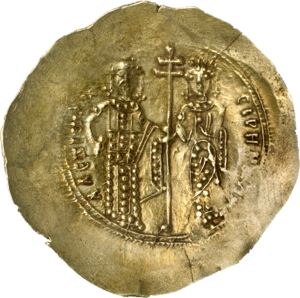
Alexios I and his wife, Irene Doukaina, had the following children:
- Anna Komnene (born 1083 – died between 1148 and 1155): As a baby, she was planned to marry Constantine Doukas. She was treated as a co-ruler by her father until her brother John was born. In 1097, she married Nikephoros Bryennios the Younger. After Alexios died, she tried to take the throne but failed. She then went to a monastery and wrote a famous history book about her father's reign.
- Maria Komnene (born 1085 – died after 1136): She married Nikephoros Katakalon.
- John II Komnenos (born 1087 – died 1143): He became the next emperor.
- Andronikos Komnenos (born 1091 – died 1130/31): He was a military leader and fought in several campaigns.
- Isaac Komnenos (born 1093 – died after 1152).
- Eudokia Komnene (born 1094 – died around 1129).
- Theodora Komnene (born 1096): She married two times. Through her second marriage, she became the grandmother of two later emperors. She is also an ancestor of many royal families in Europe today.
- Manuel Komnenos (born 1097): He is only known from one old book and likely died soon after birth.
- Zoe Komnene (born 1098): She is also only known from one old book and likely died soon after birth.
See Also
 In Spanish: Alejo I Comneno para niños
In Spanish: Alejo I Comneno para niños
Images for kids


